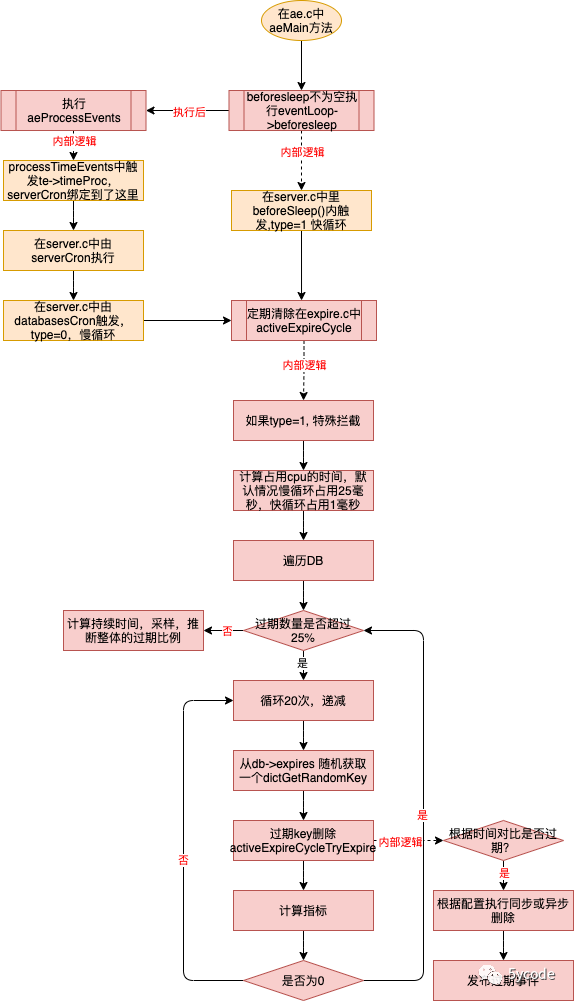在之前的 redis的key过期了还能取出来?,在这里对key的过期策略进行了简单的分析,惰性过期和定期过期,对定期清理这块讲的并不透彻,这次来根据源码分析下。
先上下逻辑,此逻辑图根据redis官方5.0分支梳理。
定期过期-慢循环
在redis源码阅读二-终于把redis的启动流程搞明白了这一文中。
我们知道redis启动会注册一个Time Event 事件,里面的执行逻辑是:serverCron 在server.c中,其中databaseCron()函数中会调用慢循环进行过期key清理。
int serverCron(struct aeEventLoop *eventLoop, long long id, void *clientData) {
updateCachedTime(1);
//hz的默认值是10
server.hz = server.config_hz;
//开启动态调整
if (server.dynamic_hz) {
/**
* 默认10000 clients 算出来 server.hz= 80hz,hz最大500
*/
while (listLength(server.clients) / server.hz >MAX_CLIENTS_PER_CLOCK_TICK){
server.hz *= 2;
if (server.hz > CONFIG_MAX_HZ) {
server.hz = CONFIG_MAX_HZ;
break;
}
}
}
/**
* 1,处理超时key,发送过期事件并删除
* 2,内存碎片整理
* 3,rehash
*/
databasesCron();
}
/**
* 1,处理超时key,发送过期事件并删除
* 2,内存碎片整理
* 3,rehash
*/
void databasesCron(void) {
//随机抽样处理过期key,只处理master,从库由master同步
if (server.active_expire_enabled) {
if (server.masterhost == NULL) {
//慢循环
activeExpireCycle(ACTIVE_EXPIRE_CYCLE_SLOW);
} else {
expireSlaveKeys();
}
}
/* Defrag keys gradually. */
//碎片处理
if (server.active_defrag_enabled)
activeDefragCycle();
//调整hash表大小,并进行rehash
if (server.rdb_child_pid == -1 && server.aof_child_pid == -1) {
}
}
定期过期-快循环
在每次循环前,都会有一次beforesleep的调用,在beforeSleep()函数里触发了快循环,具体代码如下:
void aeMain(aeEventLoop *eventLoop) {
eventLoop->stop = 0;
//只要没有停止,就循环执行,这个是主线程
while (!eventLoop->stop) {
if (eventLoop->beforesleep != NULL)
eventLoop->beforesleep(eventLoop);
aeProcessEvents(eventLoop, AE_ALL_EVENTS|AE_CALL_AFTER_SLEEP);
}
}
/**
* @brief 循环处理前执行
*
* @param eventLoop
*/
void beforeSleep(struct aeEventLoop *eventLoop) {
//激活快循环
if (server.active_expire_enabled && server.masterhost == NULL)
//执行快循环
activeExpireCycle(ACTIVE_EXPIRE_CYCLE_FAST);
}
使用自适应算法的过期处理activeExpireCycle
最核心的逻辑在这里,从5.0分支来看,快循环是执行不了的。但是代码从3.0到6.0都有这个逻辑。
/**
* @brief 使用自适应算法让一些超时key 过期
* 如果key少,使用较少的cpu时间片处理
* 如果key多,会使用较多的cpu时间片
* type为1,占用cpu时间片只有一毫秒,
* type为0,占用cpu的时间片根据默认server.hz大约占用25毫秒
* 开启server.dynamic_hz时,根据链接数算出来的刷新频率来,一万链接大概3.1毫秒,链接数越多占用时间越多
* @param type type有两个值,0和1
* ACTIVE_EXPIRE_CYCLE_SLOW 0
ACTIVE_EXPIRE_CYCLE_FAST 1
*/
void activeExpireCycle(int type) {
/**
* @brief static 静态变量作用域是本文件,在本文件内是共享,反复进入都是用的同一个值
*/
static unsigned int current_db = 0; /* Last DB tested. */
/**
* 超过时间限制会把timelimit_exit设置为1,然后退出,
* 快循环进来就不会执行
* 慢循环进来会把timelimit_exit重新置为0
*/
static int timelimit_exit = 0; /* Time limit hit in previous call? */
static long long last_fast_cycle = 0; /* When last fast cycle ran. */
int j, iteration = 0;
int dbs_per_call = CRON_DBS_PER_CALL;
/**
* start 开始执行时间
* timelimit 限制执行时间
* elapsed now()-start 已经使用的时间
*/
long long start = ustime(), timelimit, elapsed;
if (clientsArePaused()) return;
//快循环
if (type == ACTIVE_EXPIRE_CYCLE_FAST) {
/* Don't start a fast cycle if the previous cycle did not exit
* for time limit. Also don't repeat a fast cycle for the same period
* as the fast cycle total duration itself. */
/*
*如果是0,就直接返回,看注释的意思,如果是timelimit_exit=1,快循环不再进来,但是代码却将timelimit_exit=0给拦截了
* 这代码从3.0就有了,到6.0加了一个判断条件,后续再研究下别的版本分析下
*/
if (!timelimit_exit) return;
// 如果和上次执行时间差2000微秒以内,也不执行
if (start < last_fast_cycle + ACTIVE_EXPIRE_CYCLE_FAST_DURATION*2) return;
last_fast_cycle = start;
}
if (dbs_per_call > server.dbnum || timelimit_exit)
dbs_per_call = server.dbnum;
/**
* @brief 最多占用微秒数,这里限制过期处理的时间
* 未开启server.dynamic_hz的时候,server.hz=10,timelimit=25000微秒,25毫秒
* 开启server.dynamic_hz的时候
* 10000 clients server.hz是80,timelimit=3125微秒 约3.1毫秒
*/
timelimit = 1000000*ACTIVE_EXPIRE_CYCLE_SLOW_TIME_PERC/server.hz/100;
//慢循环会重新置为0
timelimit_exit = 0;
//=0就给默认值1微秒
if (timelimit <= 0) timelimit = 1;
//快速模式的情况下只占用1毫秒
if (type == ACTIVE_EXPIRE_CYCLE_FAST)
timelimit = ACTIVE_EXPIRE_CYCLE_FAST_DURATION; /* in microseconds. */
/* Accumulate some global stats as we expire keys, to have some idea
* about the number of keys that are already logically expired, but still
* existing inside the database. */
/**
* @brief 采样
*/
long total_sampled = 0;
long total_expired = 0;
//遍历db
for (j = 0; j < dbs_per_call && timelimit_exit == 0; j++) {
//默认值为0
int expired;
redisDb *db = server.db+(current_db % server.dbnum);
/* Increment the DB now so we are sure if we run out of time
* in the current DB we'll restart from the next. This allows to
* distribute the time evenly across DBs. */
current_db++;
/* Continue to expire if at the end of the cycle more than 25%
* of the keys were expired. */
/**
* @brief 过期比例超过25%会循环直到时间限制为止
*/
do {
unsigned long num, slots;
long long now, ttl_sum;
int ttl_samples;
//迭代次数,是总的迭代次数,和db无关
iteration++;
//当前db.expires的总大小为0,跳出当前循环,直接执行下个db
if ((num = dictSize(db->expires)) == 0) {
db->avg_ttl = 0;
break;
}
//当前db.expires使用总数
slots = dictSlots(db->expires);
now = mstime();
//如果使用占比<1%,不处理
if (num && slots > DICT_HT_INITIAL_SIZE &&
(num*100/slots < 1)) break;
//每次都重新计算过期数
expired = 0;
ttl_sum = 0;
ttl_samples = 0;
//每次执行只处理20个
if (num > ACTIVE_EXPIRE_CYCLE_LOOKUPS_PER_LOOP)
num = ACTIVE_EXPIRE_CYCLE_LOOKUPS_PER_LOOP;
while (num--) {
dictEntry *de;
long long ttl;
//随机取一个,没取到就跳出循环
if ((de = dictGetRandomKey(db->expires)) == NULL) break;
ttl = dictGetSignedIntegerVal(de)-now;
/**
* @brief 触发删除并发送过期事件,成功,expired+1
* 采样到的可能没有到期
*/
if (activeExpireCycleTryExpire(db,de,now)) expired++;
if (ttl > 0) {
ttl_sum += ttl;
ttl_samples++;
}
//总采样数
total_sampled++;
}
//总过期数
total_expired += expired;
/* Update the average TTL stats for this database. */
if (ttl_samples) {
long long avg_ttl = ttl_sum/ttl_samples;
/* Do a simple running average with a few samples.
* We just use the current estimate with a weight of 2%
* and the previous estimate with a weight of 98%. */
if (db->avg_ttl == 0) db->avg_ttl = avg_ttl;
db->avg_ttl = (db->avg_ttl/50)*49 + (avg_ttl/50);
}
//迭代16次,就有一次逻辑处理,为了不阻塞正常的业务处理
if ((iteration & 0xf) == 0) { /* check once every 16 iterations. */
elapsed = ustime()-start;
//执行时间超过了timelimit直接中断,如果没有直到
if (elapsed > timelimit) {
//超时设置timelimit_exit=1
timelimit_exit = 1;
server.stat_expired_time_cap_reached_count++;
break;
}
}
//如果过期key超过25%,就会一直执行,直到超过了时间限制
} while (expired > ACTIVE_EXPIRE_CYCLE_LOOKUPS_PER_LOOP/4);
}
//计算持续时间
elapsed = ustime()-start;
latencyAddSampleIfNeeded("expire-cycle",elapsed/1000);
/* Update our estimate of keys existing but yet to be expired.
* Running average with this sample accounting for 5%. */
double current_perc;
if (total_sampled) {
//当前的过期比例
current_perc = (double)total_expired/total_sampled;
} else
current_perc = 0;
//设置可能过期的比例
server.stat_expired_stale_perc = (current_perc*0.05)+
(server.stat_expired_stale_perc*0.95);
}
-
快慢循环都会改变timelimit_exit的值,按理说快循环会快但是从梳理代码来看,快循环在timelimit_exit为0 的时候是不会进来的,代码 if (!timelimit_exit) return 这块进行了拦截
-
一旦redis中有过多的key过期,redis会循环删除,以16次为一个周期,代码(iteration & 0xf) == 0,去判断执行时间有没有超过timelimit,有就跳出,执行别的业务
-
所以说呢,redis大量的过期key,在redis采样删除时,默认情况超过25%不会完全阻塞redis,只是周期性的阻塞25毫秒,但是如果25毫秒阻塞,5毫秒执行任务(5/6的时间都在阻塞了),这时候的redis对外的性能会急剧下降
注释代码地址:https://github.com/yxkong/redis/tree/5.0
redis源码阅读系列:
redis源码阅读四-我把redis6里的io多线程执行流程梳理明白了
